© Liane Fisher 2006
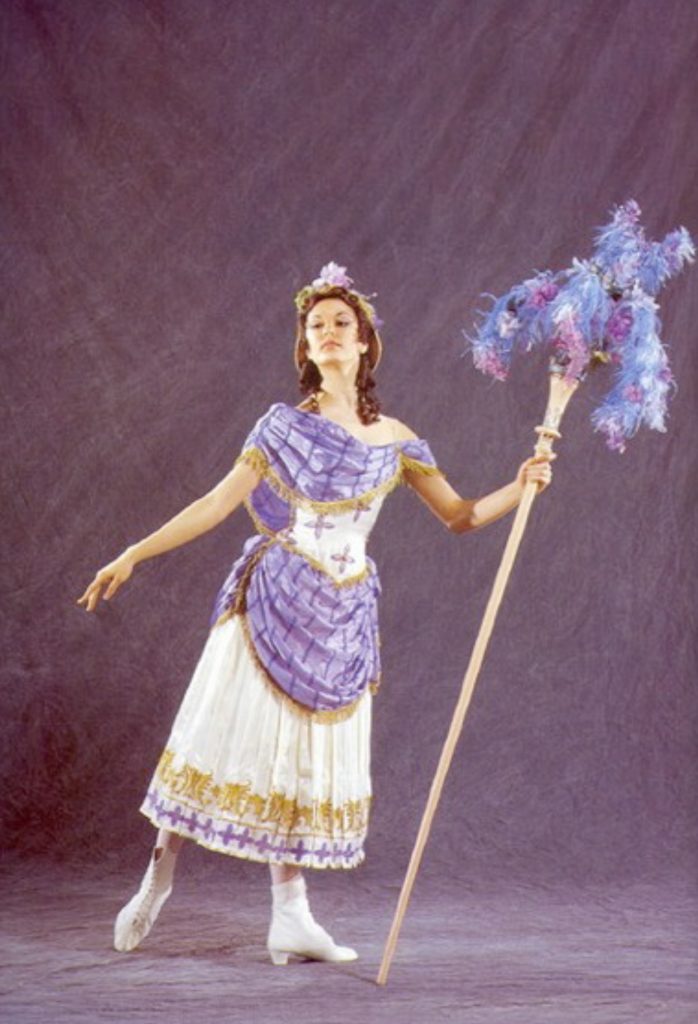
Fig. 21 Veronika Part as the Lilac Fairy in the Kirov’s reconstruction of the 1890 Sleeping Beauty, 1999.
The fairytale had come into vogue in literature at the end of the seventeenth century, when Charles Perrault published his Histoires ou contes du temps passé, in 1697 (Canton 29). Ballets based on fairytales had been produced occasionally throughout the nineteenth century. Didelot had staged Cinderella in 1823 and Sleeping Beauty had been staged twice in Paris. However, it was not until Petipa that the fairytale became firmly established as a source for thematic material for ballet: “The romantic era of the beginning of nineteenth century Europe, with its infatuation with the supernatural and the ethereal ideal of the ballerina certainly set the ground for the fairy tale ballet format. But it was with Petipa that fairy tales turned into a prototype for ballet librettos” (Canton 67).
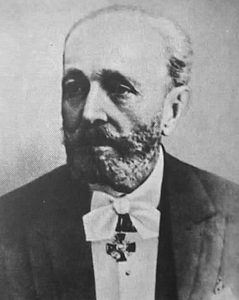
Fig. 22 Marius Petipa
At the end of the nineteenth century, Marius Petipa produced several ballets based on the literary fairytale. The first of these, premiering in 1890, was the Sleeping Beauty. The idea for producing the Sleeping Beauty is attributed to Ivan Vsevolovzhsky who had become Director of the Imperial Theaters in Russia in 1881. In 1888, Vsevolovzhsky proposed his idea for the libretto to Tchaikovsky. At the end of the same year, Petipa and Tchaikovsky met to work out the details. According to dance history scholar, Giannandrea Poesio, “the French ballet master and the great composer could have easily adapted a few pièces d’occasion to a rather plain plot…instead they both went through a detailed analysis of the project, taking into consideration the complex chromatic palette of symbols which lay within the tale” (Poesio, Beauty 38). A close examination of these symbols will reveal the richness of the web of intertexts contained within the ballet. Indeed, as we shall see, the Sleeping Beauty contains many associations with Greek mythology and a rich tapestry emerges from the interweaving of the different threads of the stories.
There have been many re-stagings of the Sleeping Beauty over the years since its premiere in 1890, however the version described below is the Kirov’s reconstruction of the original 1890 Petipa version, based on documents in the Sergeyev Collection at Harvard University. This version of the ballet has been chosen because the costumes, sets and staging are the closest to the original that the modern audience can see.
Prologue
The Overture begins and the drapes are drawn back, revealing a vase full of lilacs. To choose this scene as the opening of the ballet reveals the Lilac Fairy’s centrality to the plot, and perhaps foreshadows her ultimate triumph.
The opening scene is set in a castle and recalls the court of Louis XIV. In a letter to Tchaikovsky, Vsevolozhsky specified that this was his intention: “I want to do the mise-en-scène in the style of Louis XIV. Here the musical imagination can be carried away, and melodies composed in the spirit of Lully, Bach, Rameau” (Wiley, Tchaikovsky 104). In this court scene, entrances are made formally by rank. The scene is a display of social order and is thus associated with the Apollonian order of Olympus- a fact underscored by the reference to Louis XIV who was named the ‘Sun King’ because of his role as Apollo the sun god in Le Ballet de la Nuit. The sun association continues with the name of the princess: Aurora. “Aurora” is the name of the goddess of Dawn, the daughter of the sun god Hyperion. In mythology, she accompanied Apollo in a chariot across the sky, heralding the arrival of day. In Perrault’s original Sleeping Beauty, the princess gives birth to two children: Aurora and Jour, or Day in English. Similarly, in the Pentamerone, the antecedent to Perrault’s version of Sleeping Beauty, the two children are Sun and Moon, while the name of the princess is Thalia, who in mythology is one of the three graces – the personification of beauty, charm and grace, hence the sleeping ‘Beauty’. In Greek mythology Sun and Moon are Aurora’s siblings. Clearly, then, Aurora is associated with the coming of the light and the sun as well as Apollo and, therefore, Apollonian order.
Sleeping Beauty is an allegorical ballet, and its allegory is multilayered. First, the presentation of Aurora reproduces the life cycle, with each section of the ballet evoking infancy, youth, love & marriage, respectively. The name given by Vsevolovzhsky, Aurora, or Dawn, has implications of rebirth and springtime. This aspect was already perceived by Russian critics such as Boris Asafiev at the time of its première. (Canton 50)
After the arrival of the royal entourage, the guests enter, including a retinue of fairies, whose names symbolize the qualities of courtliness expected of a princess. Poesio says that although “contemporary audiences do not pay much attention to the names of ballet characters…these are an essential clue to the understanding of Sleeping Beauty” (Poesio, Beauty 38). The fairy Candide, meaning ‘candid’, gives the gift of purity and truth. The Fairy Coulante is also known as Fleur de Farine. Coulante means flowing or running. Fleur de Farine has two meanings, one of which is ‘flour.’ Flour used for face powder, may refer to beauty. Fleur de Farine is also the common name of a flower purported to have the power of making people dance. Therefore, this fairy seems to be giving both the gift of beauty and the gift of dancing (a very important ability at the court of Louis XIV). The fairy called Miettes Qui Tombent, meaning ‘falling breadcrumbs,’ gives the gift of fertility because, according to Poesio, there is an old Russian tradition that spreading breadcrumbs on a girl’s cradle will ensure her ability to produce children (Poesio, Beauty 38). The fairy called Canari Qui Chant, or ‘canary that sings,’ bestows the gift of song. The next fairy is Violente (‘violent’) whose gives the gift of power and the ability to command (Poesio, Beauty 38). Finally, and most importantly is the Lilac Fairy. In Russian folklore lilac represents wisdom and is placed over a baby’s cradle as a blessing for wisdom (Poesio, Beauty 38). That the Lilac Fairy is the Fairy of Wisdom hints at a link with the goddess of wisdom, Athena. Together, these fairies establish the traits that are desirable in a princess: she should be able to dance and sing well, be able to provide an heir, and be able to command and rule with truth and wisdom.
However, before the Lilac Fairy can bestow her gift of wisdom, she is interrupted by the arrival of the uninvited fairy Carabosse. According to Joseph Campbell, the herald of adventure is often “dark, loathly, or terrifying, judged evil by the world” and is “representative of that unconscious deep…wherein are hoarded all of the rejected, unadmitted, unrecognized, unknown, or undeveloped factors, laws, and elements of existence…a veiled, mysterious figure [representing] the unknown” (Campbell 52-53). Carabosse is certainly dark, loathly and terrifying. The appearance of Carabosse at court disrupts the festivities, cutting them short, and placing a curse on the infant Aurora. Her curse, of course, is that the princess will die by pricking her finger on a spindle. The association with spinning here is not arbitrary. All of the Sleeping Beauty antecedents share in common that the princess pricks her finger on a splinter of flax used for spinning. The spindle then, is perhaps the central motif in the Sleeping Beauty. The three fates in Greek Mythology are spinners. One spins the thread of life, one measures it, and the third, Atropos, cuts the thread. By choosing the spindle as the vehicle for her curse of death, Carabosse links herself with Atropos and fate. Atropos cuts short the life thread of people’s destiny as Carabosse plans to cut short the life of Aurora. In one symbol it embodies the ideas of Apollonian order versus Dionysian chaos, transformation and resurrection, the death of one stage of life and the beginning of another, and fate and destiny. Furthermore, spinning is associated with death and resurrection in the labyrinth tale, which is why we see “Ariadne with a kind of bobbin at her waist… From that spool unwinds through all the maze’s corridors the string held, at the other end, by her soon to be faithless lover (Theseus). The thread is his link to her and his means of safe rebirth into the light ” (Miller 121).
Many myths, folktales, and fairytales involve a type of death and rebirth, and the Sleeping Beauty is no exception. For of course, although Carabosse curses the princess with death, the Lilac Fairy wisely intervenes, changing the curse so that it becomes only the death of the princess’ childhood stage of life. After one hundred years of sleep, the aptly named Princess ‘Aurora’ will awaken to the ‘dawn’ of the next stage of her life. After the Lilac Fairy has mitigated Carabosse’s curse in the prologue, we proceed ahead 20 years.
Act I
Act I opens by reminding us of the centrality of the spindle to the plot. Women who are caught spinning are threatened with death by King Florestan. Aurora too was threatened by death on account of a spindle. One wonders if the King is aware of the irony in this. Happily, and perhaps not coincidentally, they, like Aurora, receive a reprieve.
Next is Petipa’s famous garland waltz. Peasant youths and maidens enter with baskets and flower garlands and perform what appears to be a May Day dance in celebration of the arrival of spring, reminding us of Persephone’s springtime return. The fact that Dawn refers to the return of the sun and, therefore, spring, links Aurora with Persephone:
“In …folklore legends, both the act of sleeping and that of awakening are connected with the cycle of the seasons, and Perrault affirmed that he had been inspired by an old story of the Pyrenees according to which the Green Man was restored to life on May Day by the kiss of his fiancée. Aurora, therefore, can be seen as the symbol of spring and of the rising sun- hence Dawn…In Greek mythology, the tale of the Sleeping Beauty can be compared with that of Persephone who returns from the underworld in the springtime”.
(Poesio, Beauty 39)
After the garland dance, we return to the court, where Aurora’s birthday party is in progress. Though she dances with four suitors, she shows no preference for any of them. She refuses to move out of childhood and into adulthood by marriage. This must be accomplished for her via the curse of Carabosse, who as we determined earlier is the ‘herald of the adventure’.
“The herald’s summons may be to live…or…to die. It may sound the call to … “the awakening of the self.”…The call rings up the curtain, always, on a mystery of transfiguration- a rite, or moment, of spiritual passage, which…amounts to a dying and a birth. The familiar life horizon has been outgrown; the old concepts, ideals, and emotional patterns no longer fit; the time for the passing of a threshold is at hand”. (Campbell 51)
Carabosse appears disguised as an old crone (like Atropos) and gives Aurora the spindle. Tchaikovsky himself describes the next part of the scene as follows: “As Aurora begins her ‘danse-vertige’ before dropping lifeless, the [Carabosse] motif suddenly springs to life and reveals its power by actually ‘spinning’ the tune to which she dances, weaving the very web of witchcraft that is entangling her” (Pritchard). Tchaikovsky’s choice of words is fascinating and reveals the composer’s deliberate incorporation of the spindle theme into the very fabric of the music. Here, Tchaikovsky associates spinning with magic and enchantment. As Kruger points out, “Weaving by women is …often linked to ideas of enchantment, for the Greeks recurrently associate textiles (and their production) with magic” (Kruger 54). Indeed, the verb “to weave” is defined by the ancient Indo-Europeans as having a correlation with the weaving of spells, poetry, and prophecy (Kruger 87).
The curse of Carabosse/Atropos disrupts or cuts the thread of time itself, causing it to stand still. According to Kruger, this element of the suspension of time is linked to weaving and spinning: “In the production of Penelope’s unfinished shroud or Helen’s tapestry woven as Homer weaves his poem, the weaving process becomes emblematic of timelessness, or time postponed” (Kruger 57). Carabosse then, associated with Atropos, is a spinner of fate whose main function is disruption. She disrupts scenes, disrupts life stages and disrupts time itself. According to Zipes, scholar of fairy tales and folklore, this is precisely what makes her a villain:
The villains are those who use words intentionally to exploit, control, transfix, incarcerate and destroy for their benefit. They have no respect or consideration for nature and other human beings, and they actually seek to abuse magic by preventing change and causing everything to be transfixed according to their interest. Enchantment= petrification. Breaking the spell=emancipation”.
(Zipes 5-6)
The princess’ state of suspended animation – her deathlike sleep- takes place when the princess is on the cusp between childhood and adulthood. When the princess awakens, she will immediately enter her new phase of adulthood and marriage. Interestingly, art historian, Dr. Penny Jolly, notes that in the middle ages “sleep was associated with the abandonment of rational faculties in favor of sensual pursuits” (Jolly 32). Even today a popular euphemism for such activities is “sleeping” together. Given that, in the antecedent to Perrault’s version of Sleeping Beauty found in the Arabian Nights, the sleeping princess loses her virginity while asleep and begets two children, the association of sleep with “sensual pursuits” fits. It may also be that the loss of blood from pricking her finger may be a euphemism for the loss of virginity. In any case, Aurora is about to undergo the transformation from childhood to womanhood and to accomplish this, her previous self must undergo a type of death. Aurora pricks her finger and falls as if dead, and Carabosse throws off her cloak, revealing her identity, whereupon she is chased off-stage. A fountain with a statue of Neptune suddenly lights up and magical music plays as the Lilac Fairy puts the entire kingdom to sleep.
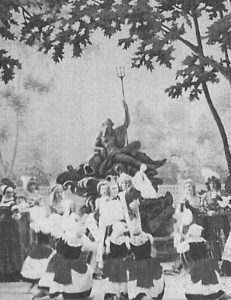
Fig. 24 Statue of Neptune, Act I Sleeping Beauty, Kirov 1999 (Scholl 43)
Why is attention brought to the fountain at this time and why is there a statue of Neptune? Perhaps the fact that the statue of Neptune is included here is a reference to Athena’s mother, the Oceanid, Metis (also a goddess of wisdom). It could refer to Theseus, Poseidon’s son, according to some. It may also refer to the fact that the flights of Aurora and her siblings starts and finishes from Oceanos. Significantly too, the fountain was also present in another great and famous ballet, the Ballet Comique de la Reine. In this ballet, celebrating a marriage, the fountain’s inclusion was used as a reference to the fountain of youth and, because of the dolphins present on the fountain, to ask for an heir. It would seem that its use in sleeping beauty could well be the same. In addition, as Joseph Campbell elucidates in his analyses of myths, the fountain could herald the call to adventure: “Typical of the circumstances of the call are the dark forest, the great tree, the babbling spring” (Campbell 51). Or again, perhaps the fountain is a reminder of the Christian baptismal font, a symbol of transformation and a reminder of resurrection, for in literature “…the water of transformation [is] known to all systems of mythological imagery” (Campbell 250-251). Perhaps, too, the fountain of water is used as a symbol while the castle inhabitants are being put to sleep because “the well is symbolical of the unconscious” (Campbell 74). If, as Cambell suggests, the fountain is, like the forest, the symbol of the call to adventure, the beginning of the magical journey, it is well placed at this moment, for this is when Carabosse’s curse takes effect and when the Lilac Fairy begins to weave her magic.
As the Lilac Fairy puts the kingdom to sleep, Vsevolovzhsky writes in the libretto, “ivy and creepers grow up out of the earth and cover the castle… Trees and large bowers of lilacs flourish magically as a result of the fairy’s influence, and transform the royal garden into an impenetrable forest” (Wiley, Century 369). As Carabosse’s curse takes over, the Castle, representing Apollonian society, is covered in ivy, symbolic of Dionysos. But, the curse is also mitigated by the Lilac Fairy, so there is also Lilac growing over the castle. Not only is the forest a symbol of the call to adventure it is also used in literature as a labyrinthine place where transformation takes place. Transformation is traditionally the theme of most fairytales: “More than any other literary genre, the fairy tale has persisted in emphasizing transformation…with spells, enchantments, disenchantments, resurrections, recreations” (Zipes 2).
Act II
Act II picks up the thread of the story one hundred years later, as is revealed by the change in dress of the characters. The setting is a woodland glade with a stream running through. In the background, the turrets of a castle can be seen above the trees. Here, we are introduced to Prince Desiré who is out on a hunting party. The party settles down to play blind-man’s-bluff. As well as adding period flavor, this may refer to destiny and fate, since seers in mythology were frequently blind.
Next, in the original 1890 version, Tchaikovsky had composed four dances: the Dance of the Duchesses, the Dance of the Baronesses, the Dance of the Countesses, and the Dance of the Marquises. These were followed by a Farandole for the peasants, in which everyone participated together. Although it is unclear whether all of these dances were actually performed at the premiere, it does seem that there was some intention to call attention to social order.
After the afore-mentioned dances, the party resumes its hunt and Prince Desiré remains behind. Almost immediately the theme of the Lilac Fairy is heard. The Lilac Fairy arrives aboard a boat. As though to confirm our hunch from the prologue, she appears dressed like Athena. Compare the following photo of the Lilac Fairy with the corresponding picture of Athena (Minerva in Roman):
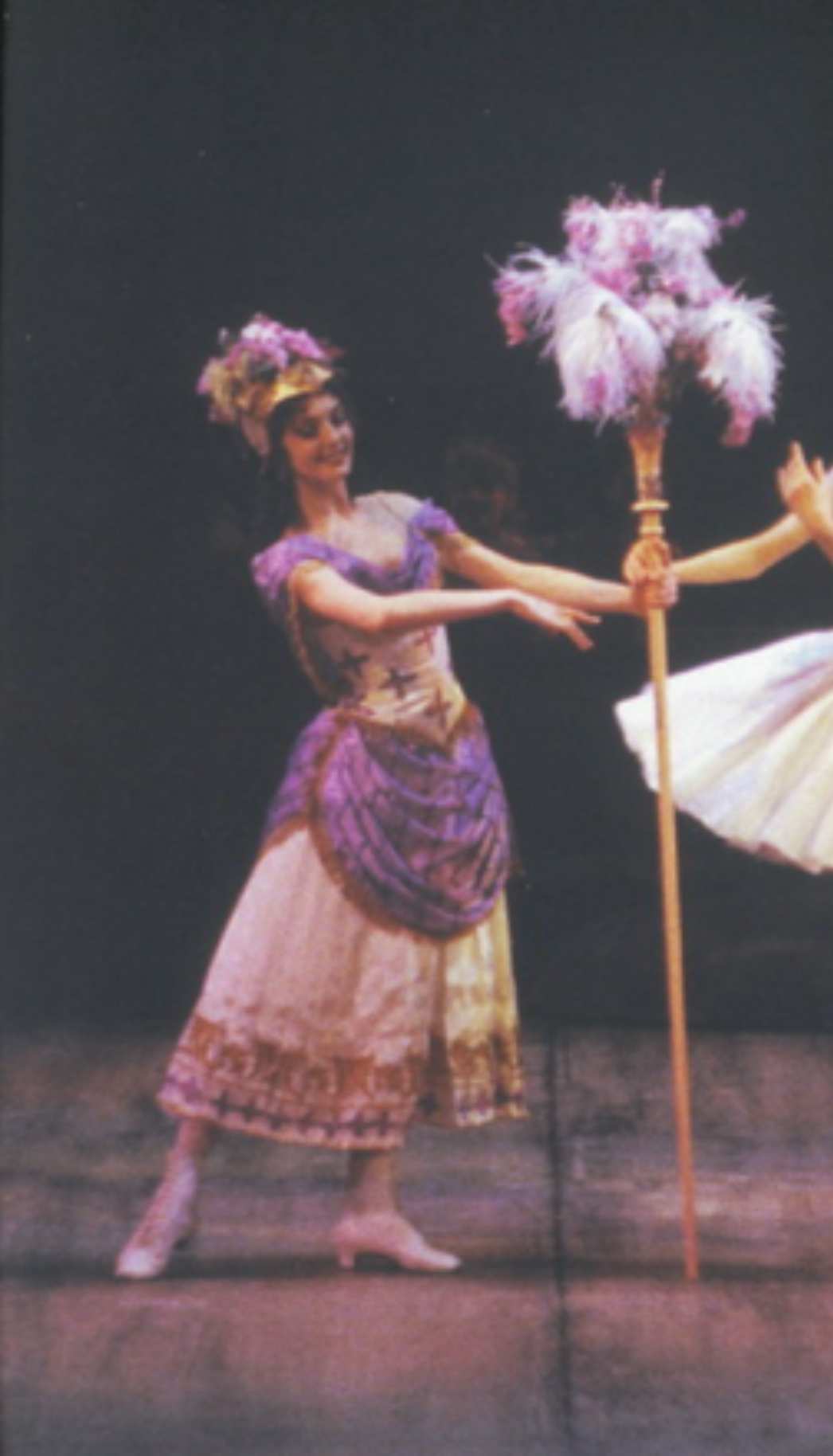 | 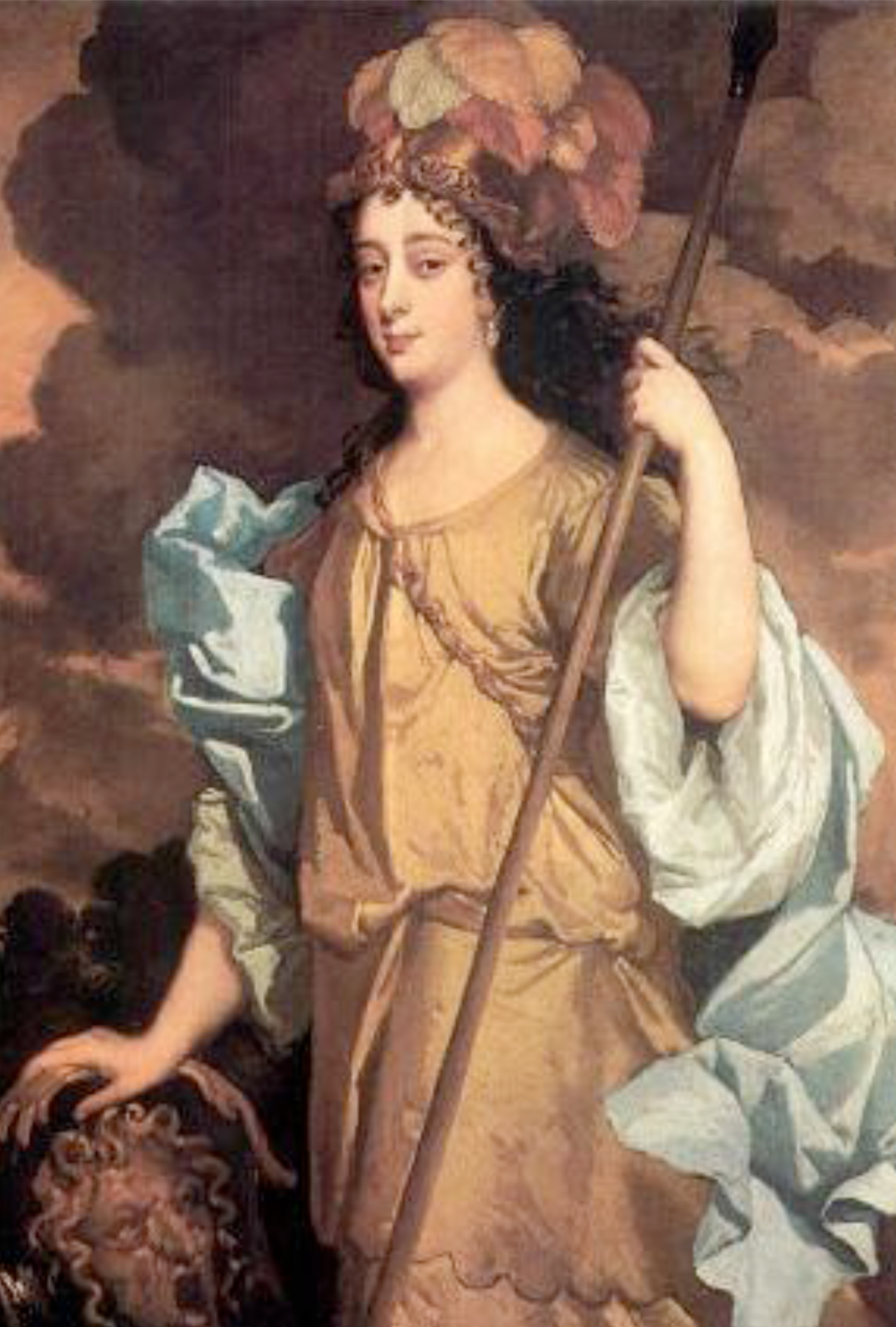 |
| Fig 25. Veronika Part, as the Kirov’s Lilac Fairy | Fig. 26. Minerva (Athena)by Peter Lely, Windsor Castle |
The Lilac Fairy, like Athena, is wearing a plumed helmet and carries a staff or spear. It is interesting that the Lilac Fairy is so closely associated with Athena, because in Greek Mythology, Athena was known for spinning. A famous myth has her competing with a mortal girl, Arachne. Athena’s tapestry depicts Apollonian order while Arachne’s depicts Dionysian chaos. Arachne was judged the better spinner, and Athena turned her into a spider- a spinner of webs. And here in the Sleeping Beauty, we have the Lilac Fairy spinning magic to preserve Apollonian order versus Carabosse who uses the spindle to weave her curse of Dionysian disruption. In a recent production of Sleeping Beauty, staged by Gelsey Kirkland at ABT, Carabosse was in fact depicted as a spider.
As Act I continues, Desiré engages in a mimed conversation with the Lilac Fairy, telling her that he finds none of the court ladies pleasing. This is a direct parallel with Act I. Aurora danced with four suitors and showed no preference; Desiré watched four dances and found none of the ladies pleasing. According to Joseph Campbell this represents a refusal to grow up and leave childhood behind and is seen in many other tales- Prince Siegfried in Swan Lake, Solor in La Bayadere, and Prince Kamar al-Zaman in the Arabian Nights, to name a few. The Lilac Fairy must also be Desiré’s guide through the labyrinth. Joseph Campbell notes that:
“The helpful crone and fairy godmother is a familiar feature of European fairy lore …The thread of Ariadne brought Theseus safely through the adventure of the labyrinth…what such a figure represents is the benign protecting power of destiny…that though omnipotence may seem to be endangered by the threshold passages and life awakenings, protective power is always and ever present within the sanctuary of the heart”. (Campbell 71-72)
In order to entice Desiré to begin his journey, the Lilac Fairy summons her powers to reveal to him a vision of Aurora’s shade or spirit.
The fact that this scene takes place in a forest is indicative of the beginning of adventure, since the forest is a known representation of the labyrinth, being dark with twisting paths and wild beasts. During the vision scene, true to romantic tradition, Aurora remains elusive as the Prince tries unsuccessfully to catch her. The fact that he cannot find his way to her is also typically labyrinthine. In fact, Poesio describes the choreography of this scene as follows: “in the vision scene, the geometrical pattern followed by the nymphs – parallel lines, squares…circular groupings around the Lilac Fairy – reproduces the architecture of the typical maze of both seventeenth and eighteenth century royal gardens in which Desiré gets lost pursuing his vision” (Poesio, Beauty 39). Interestingly, in Renaissance Quarterly, Jennifer Nevile describes the similarities between the design of dance and the design of gardens, and how they are based on the same principles. “In the Renaissance there were close similarities between the static choreography of the formal gardens of the nobility and the moving choreographies performed by members of the court. The principles of order and proportion, the expression of splendour, the geometrical forms were all fundamental principles of both” (Nevile 805). Like the labyrinth, she says that both the formal garden and court dance were designed to be viewed from above. One of the dances she mentions is described as being formed of “curious knots and mazes” (Nevile 830).
 |  |
| Fig 27. Venus by Botticelli, c. 1483 Uffizi, Florence | Fig. 28 Svetlana Zakharova as Aurora balances on a shell in the center of garlands (Scholl 35) |
At the end of the vision scene, Aurora balances on a shell in a pose that recalls Aphrodite. Aurora is “Beauty” and Aphrodite is the “Goddess of Beauty”. Also remember that Aurora’s name in the Pentamerone was Thalia, one of the graces of Aphrodite. Remember that it was Aphrodite who, on Neptune’s command (recall the statue of Neptune in the previous act), caused Pasiphae to fall in love with the bull and produce the Minotaur in the myth of the labyrinth. Additionally, Aphrodite rules the three fates and is praised by nymphs. Throughout this scene Aurora is surrounded by dancing nymphs. Recall, too, that it was Aphrodite who sent Psyche to the underworld where she fell into a deep sleep and it was Aphrodite’s son, Eros (or Cupid) who went down to the underworld to put sleep back in its box and bring Psyche back to life. Aurora’s Aphrodite-like pose not only reminds us of Aphrodite’s association with beauty, love, and marriage (all themes of Sleeping Beauty), but also lets us know that Desiré, like Eros who woke Pysche, is going to go through the labyrinth of the Underworld to resurrect his beloved Sleeping Beauty. Indeed, Desiré immediately declares his love for Aurora to the Lilac Fairy and begs to be taken to the princess. They both step into the boat and the Lilac Fairy ferries him to the gates of the house of sleep. If one equates the ‘house of sleep’ with the ‘kingdom of death’ then the Lilac Fairy acts here as Charon the Ferryman and the river is the River Styx that separates the land of the living from the land of the dead.
 | 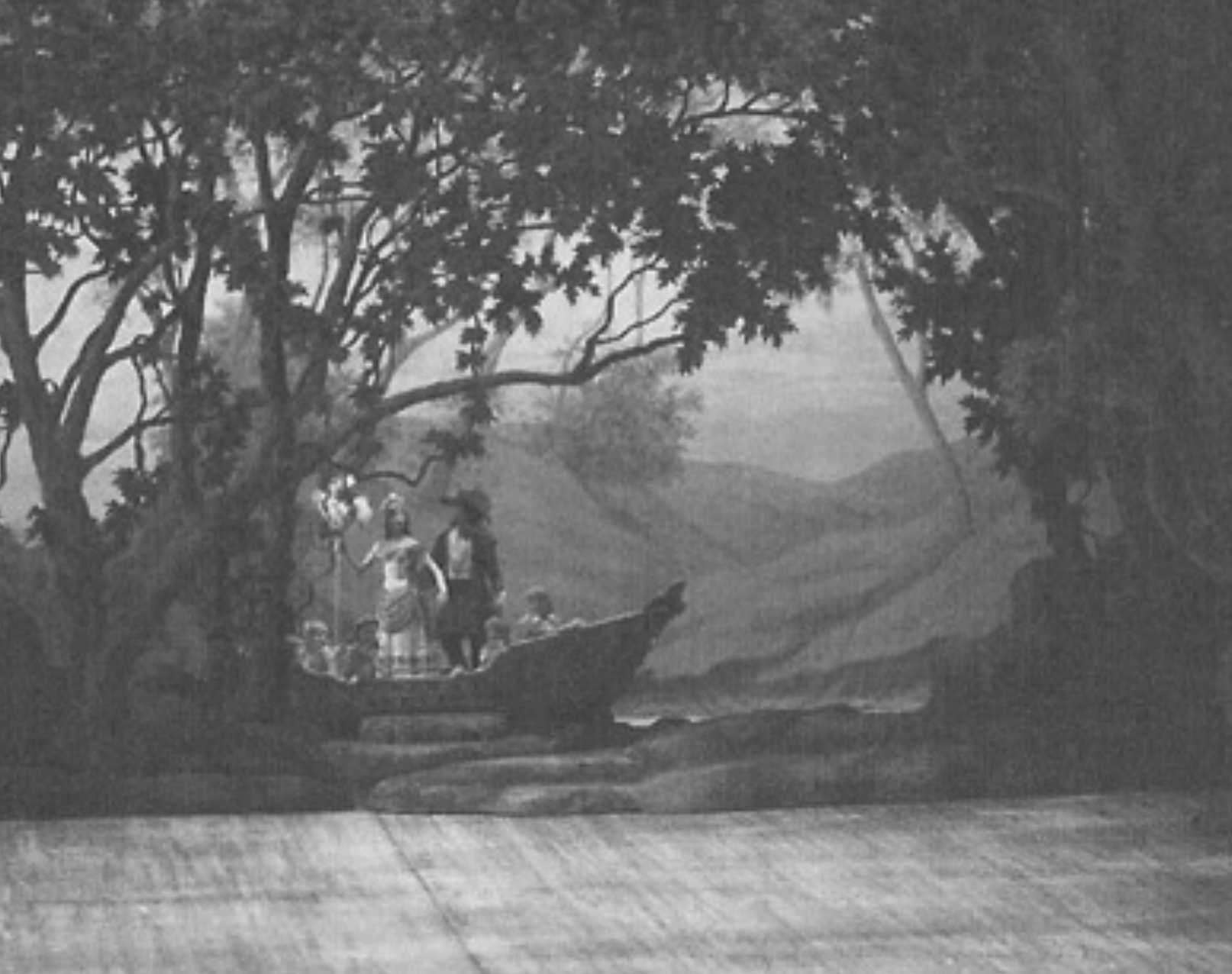 |  |
| Fig. 29 The Lilac Fairy and Desire in the boat | Fig. 30 Veronica Part as the Lilac Fairy and Viktor Baranov as Desire, Kirov 1999 (Scholl 139) | The Barque of Charon byJose Beniliure Y Gil |
With the Lilac Fairy as guide, they easily find their way through the labyrinth and through the forest that has grown up around the castle to arrive at the gates. “With a wave of her magic wand the fairy causes the gates to open. The entrance hall is visible. The stage is obscured by dense clouds. Peaceful music is heard” (Wiley, Century 371). Desiré finds the princess and kisses her. The kiss was not from Perrault, who would have found it too distasteful (Canton 59). However, in the ballet it is the device used for resurrecting Aurora and the entire court. This marks the escape from the dark labyrinth of sleep and the Underworld and the return to light and life.
Act III
The wedding scene takes place in an appropriately sunny Louis XIV garden. Louis XIV is, after all, the Sun King and Apollonian order has, indeed, been restored. The royal entourage arrives followed by the guests, including many Perrault fairy tale characters as well as some from other tales. Also among the guests are the Fairies Candide, Canari, and Violente from the Prologue along with four new fairies: Diamond, Gold, Silver, and Sapphire. The Lilac Fairy is of course present and, this time, Carabosse has not been left off the guest list. The presence of the four new jewel fairies bears some attention. Why are these new characters suddenly introduced at the wedding? Petipa described the four fairies as representing a gold charm, the tinkling of silver coins, the five facets of sapphire (for good luck), and glistening sparkles like electricity (Poesio, Beauty 41). While these fairies all have their own individual associations, together their presence at the wedding suggests a dowry.
Finally, Desiré and Aurora are united in marriage. “The ultimate adventure, when all the barriers and ogres have been overcome, is commonly represented as a mystical marriage of the triumphant hero-soul with the Queen Goddess of the World” (Campbell 109). After the marriage takes place, the garden backdrop begins to ascend, revealing first a blue background with the French fleur-de-lis, indicating that the order of King Louis XIV’s/King Florestan XIV’s court has triumphed above (literally) all else. The backdrop, however, continues to rise until we see the clouds of heaven, above which Apollo in his chariot presides. The order of the court of Apollo the Sun God is a higher court than Louis (Florestan) the Sun King’s. Petipa describes this scene in his notes: “Apollo, as the sun king Louis XIV…When [Apollo] personifies the sun, he has a cock on his shoulder and is crowned with rays of sunlight. Four white horses draw his chariot, on which the signs of the zodiac are represented” (Wiley, Tchaikovsky 156). The sun is in its rightful place in the heavens and Apollonian order reigns supreme. Directly below Apollo, indicating her importance and centrality to the ballet, is the Lilac Fairy.

Fig. 31 Apotheosis, Kirov Sleeping Beauty1890 Reconstruction, 1999 (Scholl 141)
If we were in any doubt as to whether the Lilac Fairy is in fact the goddess Athena, her position in heaven assures us of her goddess status. The divinity of the other prologue fairies is also established as they take their place to the left (from the audience’s perspective) of the Lilac Fairy. Carabosse is at audience-right, pursued by gods wielding spears. In medieval art and in baroque ballet and opera staging, the right side of a scene (from the viewer’s perspective) is traditionally sinister, while the left is benevolent. For example, in the mural entitled The Last Judgment painted by Giotto c.1305 in Padua, Italy (see fig. 32) the righteous are located in the left of the picture, while the damned are at the right. Notice too that the righteous are presented in orderly fashion and are in light colors and that the damned are falling chaotically into the dark abyss. Heaven, naturally, is always located above everything else. In this painting too, Apollonian order reigns supreme, while Dionysian chaos leads to the murky void of the Underworld.
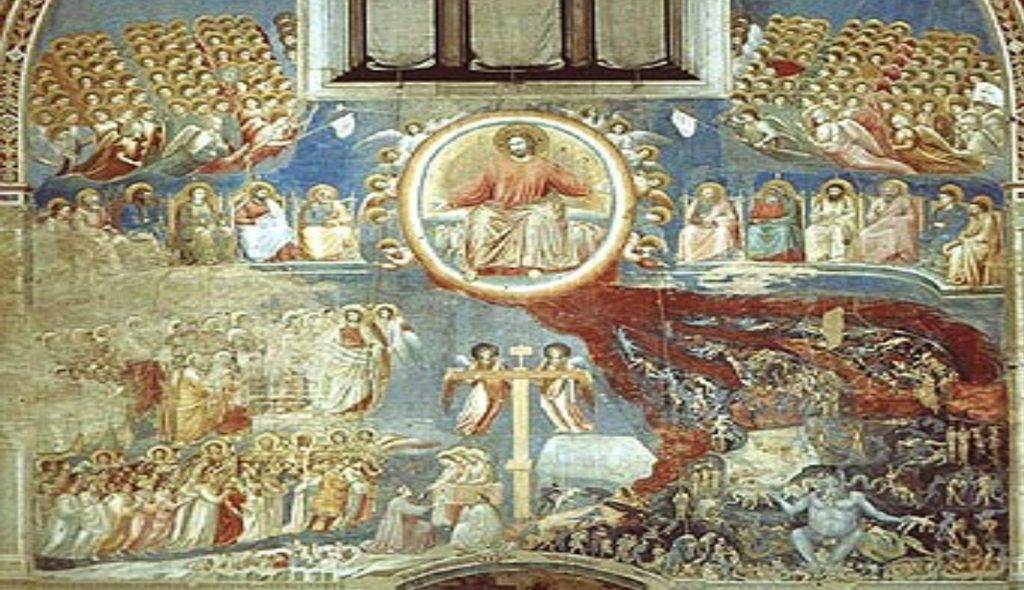
Fig. 32 The Last Judgment, Giotto c. 1305. Padua, Italy. Courtesy of Dr. Penny Jolly
In addition to Apollo, the other deities, and the fairies who populate the scene, there are many cherubs abundantly present, indicating the triumph of love. Just as Cupid saved Psyche from a deathlike sleep and had a grandiose wedding celebration presided over by gods, so too did Desiré. Before the curtain closes, many garlands of roses are lowered. Besides representing love and protection as well as perhaps being a reference to Grimm’s’ Briar Rose version of the tale, the garlands are also reminiscent of the garland dance from Act I, in which peasants celebrated the arrival of Spring. Recall Poesio’s assertion that the Sleeping Beauty is comparable to the myth of Persephone, who returns from the underworld every year to bring light to the world, releasing it from the dark of winter and heralding the start of spring. Like Persephone, Aurora leaves the dark world of sleep and brings the Dawn of light. Aurora is ready for spring and a new beginning. She is no longer reluctant to embark on the next stage of her life: marriage. This, it appears, was Perrault’s point all along: that one should not delay marriage. Perrault gives, at the end of the story, his moral: “Though philosophers may prate how much wiser ‘tis to wait, maids will be a-sighing still – young blood must when young blood will.”
The tale of the Sleeping Beauty is rife with mythological symbols and allegory, however they are hidden from today’s modern understanding because we are no longer as familiar with the references as the 19th century audience was. Of course, the spectator does not need to be able to understand and identify all of the key mythological images and symbols in the ballet. It can be enjoyed by the smallest child as simply the well-loved tale of the Sleeping Beauty. Yet, by peeling back the layers of meaning, a rich subtext is revealed, allowing dancers, choreographers and stagers to interpret the roles and the scenes in a deeper way and allowing them to communicate a richer experience to the members of the audience who are willing to allow the Lilac Fairy to guide them through the labyrinth of intertexts in the Sleeping Beauty.
Bibliography
Adshead-Lansdale, Janet. “The Concept of Intertextuality and Its Application in Dance Research.”
Proceedings of the Society of Dance History Scholars, 1999. 109-115.
Apuleius. The Golden Ass. Trans. P.G. Walsh. The World Classics. Oxford, UK: Oxford University Press, 1994.
Basile, Giambatista. The Pentamerone. Trans. John Edward Taylor. 1847. London, UK: Macmillan and Co., 1911.
Bennahum, Judith Chazin. Dance in the Shadow of the Guillotine.
Bettelheim, Bruno. The Uses of Enchantment: the meaning and importance of fairytales. New York, NY: Alfred Knopf, 1975.
Boccaccio, Giovanni. The Corbaccio. Trans. Anthony K. Casell. Chicago: University of Illinois Press, 1975.
Campbell, Joseph. The Hero with a Thousand Faces. 1949. Princeton, NJ: Princeton University Press, 1973.
Canton, Katia. The Fairy Tale Revisited. New York, NY: Peter Lang Publishing, 1994.
Carden, Patricia. Literary Criticism and Myth. Ed. Joseph Strelka. University Park and London: Penn State University Press, 1980.
Catullus. The Poems of Catullus. Trans. Charles Martin. Baltimore, MD: Johns Hopkins University Press, 1989.
De Marinis, M. The Semiotics of Performance. Bloomington, IN: Indiana University Press, 1993.
Doob, Penelope. The Idea of the Labyrinth. Ithaca, NY: Cornell University Press, 1992.
Guest, Ivor. The Romantic Ballet in Paris. Middletown, CT: Wesleyan University Press, 1966.
Homer. The Iliad. Trans. Richard Lattimore. Chicago, IL: University of Chicago Press, 1972.
Jolly, Penny Howell. Made in God’s Image?: Eve and Adam in the Genesis mosaics at SanMarco, Venice.
Berkeley and Los Angeles, CA: University of California Press, 1997.
Kern, Hermann. Through the Labyrinth. New York, NY: Prestel, 2000.
Kirstein, Lincoln. Dance: A Short History of Classical Theatrical Dancing. 1935.New York, NY: Dance Horizons, 1974.
Kruger, Kathryn Sullivan. Weaving the Word: the Metaphorics of Weaving and Female Textual Production.
Selinsgrove, PA: Susquehanna University Press, 2001.
Lawler, Lillian. The Dance in Ancient Greece. Middletown, CT: Wesleyan University Press, 1964.
Mardrus, J. C. The Book of the Thousand Nights and One Night. Trans. Powys Mathers.
London, UK: Routledge and Kegan Paul, 1964.
Miller, J. Hillis. Ariadne’s Thread: Storylines. New Haven, CT: Yale University Press, 1992.
Nevile, Jennifer. “Dance and the Garden: Moving and Static Choreography in Renaissance Europe”.
Renaissance Quarterly #52: 1999.
Ovid. Metamorphoses. Trans. Rolph Humphries. Bloomington, IN: Indiana University Press, 1955.
Pausanias. Description of Greece. Trans. W.H.S. Jones. Loeb Classical Library. Cambridge, MA: Harvard University Press, 1979.
Perrault, Charles. Perrault’s Fairytales. 1697. Trans. A. E. Johnson.Minneola, NY: Dover Publications, 1969.
Poesio, Giannandrea. “The Awakened Beauty”. The Dancing Times. London, UK: Oct 1993.
Plutarch. The Life of Theseus.
Plutarch. Plutarch’s Lives. Trans. B. Perrin. Loeb Classical Library. Cambridge, MA: Harvard University Press, 1968.
Pritchard, Jane. “English National Ballet. Program Notes.” http://www.ballet.org.uk/reference/notes/sleepingbeauty/composer.html
Scholl, Tim. “Sleeping Beauty,” a Legend in Progress. New Haven, CT: Yale University Press, 2004
Virgil. The Aeneid. Trans. Allen Mandelbaum. Berkeley, CA: University of California Press, 1971.
Winter, Marion Hannah. The Pre-Romantic Ballet. New York, NY: Dance Horizons, 1975.
Wiley, Roland. A Century of Russian Ballet: Documents and Accounts, 1810-1910. New York, NY: Oxford University Press, 1990.
Wiley, Roland. Tchaikovsky’s Ballets: Swan Lake, Sleeping Beauty, Nutcracker. Oxford, UK: Clarendon Press, 1985.
Zipes, Jack. Fairy Tales and the Art of Subversion. New York, NY: Wildman Press, 1983.
Zipes, Jack. When Dreams Came True: Classical Fairy Tales and their Tradition.
New York and London: Routledge, 1999.
